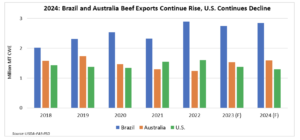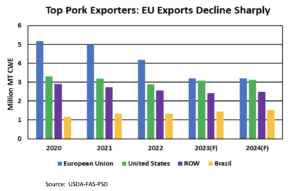FAS Highlights International Pork, Beef and Chicken Export Variables- EU Share Expected to Fall, Brazil Increase
Last week, in its quarterly Livestock and Poultry: World Markets and Trade report, USDA’s Foreign Agricultural Service (FAS) indicated that, “In 2024, EU pork, beef, and chicken meat exports are forecast to account for 15 percent of global exports, marking a significant decline from 20 percent in 2019. In comparison, total Brazil pork, beef, and chicken meat exports are forecast to increase from 20 percent to 26 percent during the same period, while the United States is expected to remain virtually unchanged at 22 percent.”

FAS pointed out that, “In 2024, EU pork exports are expected to decline 25 percent compared to 2019 and account for 15 percent of production, down from 19 percent in 2019. In addition to growing regulatory burdens, EU swine producers continue to face challenges controlling the impact of African swine fever, which has led to reductions in the swine herd and limited exports to some markets. As production contracts, the share intended for domestic consumption has grown at the expense of exports.
“Like pork, EU beef production has been negatively impacted by growing regulatory requirements and is forecast to decline 8 percent between 2019 and 2024. While the percent of production exported is only expected to decline from 10 percent to 9 percent over the same period, both exports and production continue fall.”
The FAS report added that, “EU chicken production is forecast to grow 2 percent from 2019 through 2024. However, exports as a percent of production are forecast at 16 percent in 2024, down from 20 percent in 2019. Highly Pathogenic Avian Influenza (HPAI) has constrained production growth and hence exportable supplies. HPAI-related trade restrictions have curtailed exports.”

In a closer look at beef production, last week’s report stated that, “U.S. beef production is forecast down 6 percent on tighter cattle inventories. The decline in production coupled with increased supplies in Australia will spur growth in imports and a decrease in exports. Imports are forecast at 1.7 million tons, a level only achieved in 2004. Exports are forecast 6 percent lower to 1.3 million tons, constrained by lower domestic production and price competitive supplies from other key suppliers (Australia and Brazil).”

Turning to pork production, FAS pointed out that, “U.S. production is forecast 2 percent higher in 2024 to 12.7 million tons on a strong increase to pigs per litter and falling feed costs.
U.S. exports are forecast to increase 3 percent in 2024 on strong demand from Canada, the Philippines, and South Korea as well as gaining market share from the EU in China and Australia.
With respect to chicken, the Livestock report indicated that, “U.S. production is expected to rise 1 percent to a record 21.4 million tons in 2024 on a modest decline in feed prices.

“Increased production will support a modest boost in exports which are forecast 1 percent higher to nearly 3.4 million tons, largely due to greater shipments to key markets Mexico and Canada.”
